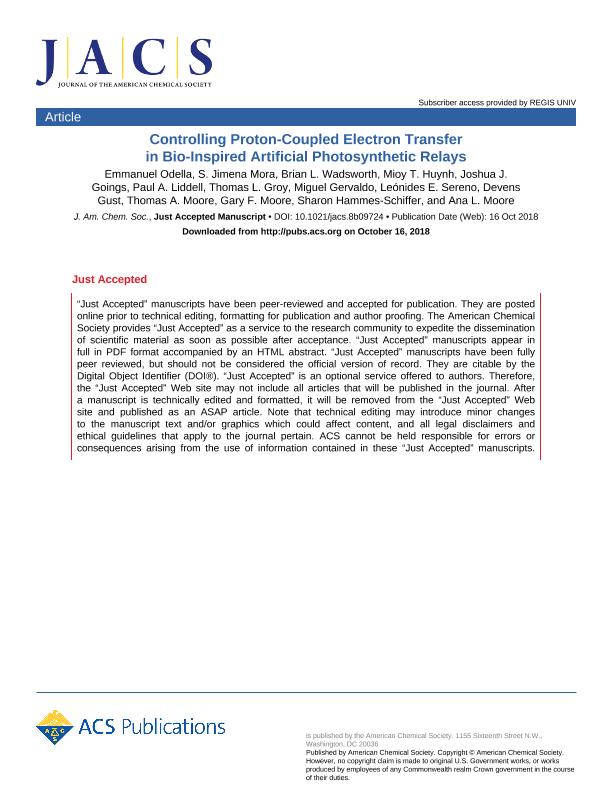Artículo
Controlling proton-coupled electron transfer in bioinspired artificial photosynthetic relays
Odella, Emmanuel ; Mora, Sabrina Jimena
; Mora, Sabrina Jimena ; Wadsworth, Brian L.; Huynh, Mioy T.; Goings, Joshua J.; Liddell, Paul A.; Groy, Thomas L.; Gervaldo, Miguel Andres
; Wadsworth, Brian L.; Huynh, Mioy T.; Goings, Joshua J.; Liddell, Paul A.; Groy, Thomas L.; Gervaldo, Miguel Andres ; Sereno, Leonides Edmundo; Gust, Devens; Moore, Thomas A.; Moore, Gary F.; Hammes-Schiffer, Sharon; Moore, Ana L.
; Sereno, Leonides Edmundo; Gust, Devens; Moore, Thomas A.; Moore, Gary F.; Hammes-Schiffer, Sharon; Moore, Ana L.
 ; Mora, Sabrina Jimena
; Mora, Sabrina Jimena ; Wadsworth, Brian L.; Huynh, Mioy T.; Goings, Joshua J.; Liddell, Paul A.; Groy, Thomas L.; Gervaldo, Miguel Andres
; Wadsworth, Brian L.; Huynh, Mioy T.; Goings, Joshua J.; Liddell, Paul A.; Groy, Thomas L.; Gervaldo, Miguel Andres ; Sereno, Leonides Edmundo; Gust, Devens; Moore, Thomas A.; Moore, Gary F.; Hammes-Schiffer, Sharon; Moore, Ana L.
; Sereno, Leonides Edmundo; Gust, Devens; Moore, Thomas A.; Moore, Gary F.; Hammes-Schiffer, Sharon; Moore, Ana L.
Fecha de publicación:
10/2018
Editorial:
American Chemical Society
Revista:
Journal of the American Chemical Society
ISSN:
0002-7863
e-ISSN:
1520-5126
Idioma:
Inglés
Tipo de recurso:
Artículo publicado
Clasificación temática:
Resumen
Bioinspired constructs consisting of benzimidazole-phenol moieties bearing N-phenylimines as proton-accepting substituents have been designed to mimic the H-bond network associated with the TyrZ-His190 redox relay in photosystem II. These compounds provide a platform to theoretically and experimentally explore and expand proton-coupled electron transfer (PCET) processes. The models feature H-bonds between the phenol and the nitrogen at the 3-position of the benzimidazole and between the 1H -benzimidazole proton and the imine nitrogen. Protonation of the benzimidazole and the imine can be unambiguously detected by infrared spectroelectrochemistry (IRSEC) upon oxidation of the phenol. DFT calculations and IRSEC results demonstrate that with sufficiently strong electron-donating groups at the para-position of the N-phenylimine group (e.g., -OCH3 substitution), proton transfer to the imine is exergonic upon phenol oxidation, leading to a one-electron, two-proton (E2PT) product with the imidazole acting as a proton relay. When transfer of the second proton is not sufficiently exergonic (e.g., -CN substitution), a one-electron, one-proton transfer (EPT) product is dominant. Thus, the extent of proton translocation along the H-bond network, either ~1.6 Å or ~6.4 Å, can be controlled through imine substitution. Moreover, the H-bond strength between the benzimidazole NH and the imine nitrogen, which is a function of their relative pKa values, and the redox potential of the phenoxyl radical/phenol couple are linearly correlated with the Hammett constants of the substituents. In all cases, a high potential (~1 V vs SCE) is observed for the phenoxyl radical/phenol couple. Designing and tuning redox-coupled proton wires is important for understanding bioenergetics and developing novel artificial photosynthetic systems.
Palabras clave:
Benzimidazole-phenol
,
Proton-coupled electron transfer
,
H-bond network
Archivos asociados
Licencia
Identificadores
Colecciones
Articulos(CCT - CORDOBA)
Articulos de CTRO.CIENTIFICO TECNOL.CONICET - CORDOBA
Articulos de CTRO.CIENTIFICO TECNOL.CONICET - CORDOBA
Citación
Odella, Emmanuel; Mora, Sabrina Jimena; Wadsworth, Brian L.; Huynh, Mioy T.; Goings, Joshua J.; et al.; Controlling proton-coupled electron transfer in bioinspired artificial photosynthetic relays; American Chemical Society; Journal of the American Chemical Society; 140; 45; 10-2018; 15450-15460
Compartir
Altmétricas



